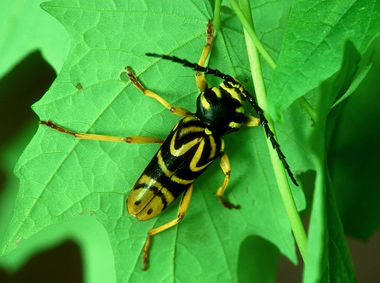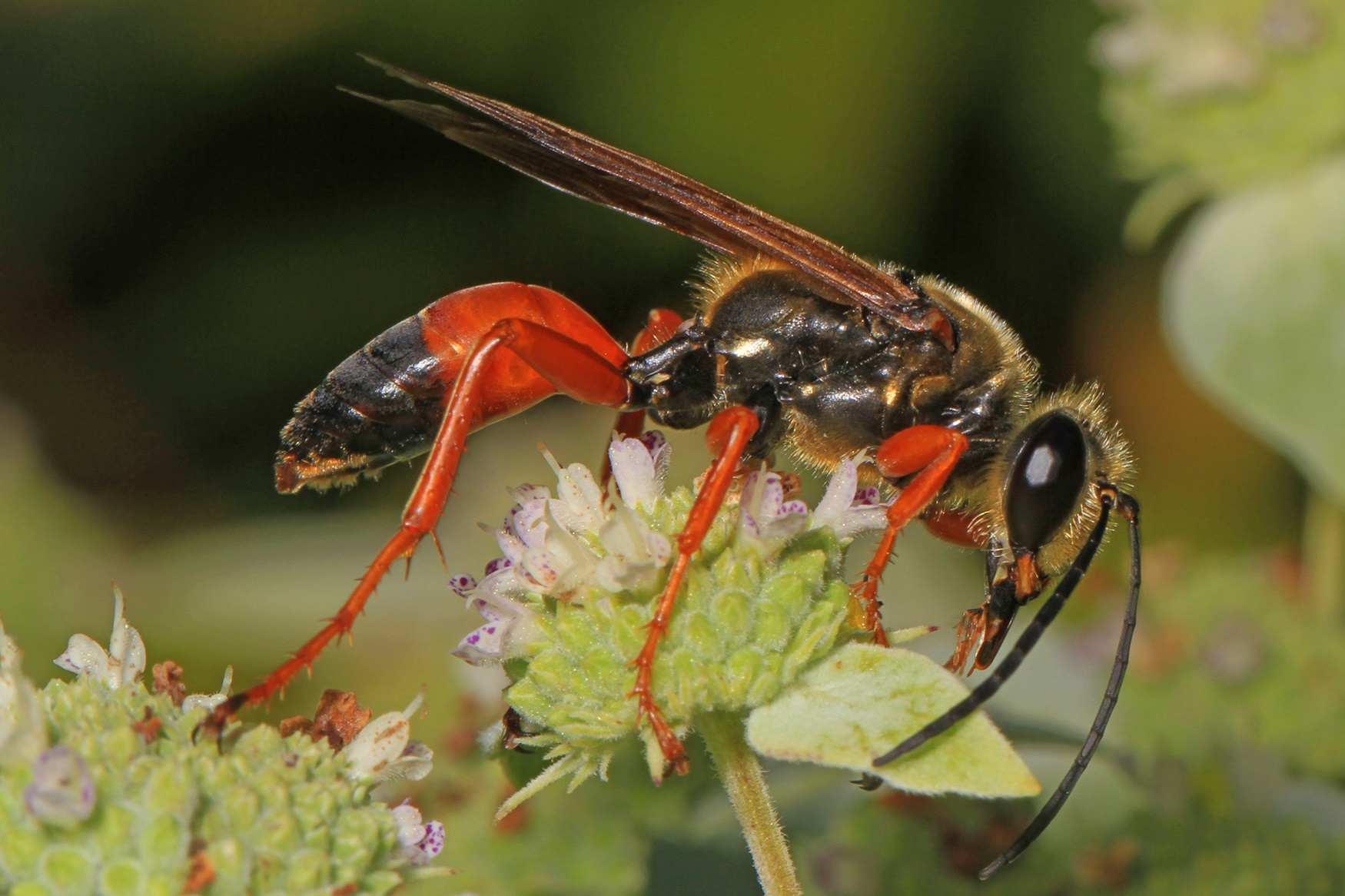Hornet is the common name for wasps in the genus Vespa. They are members of the insect family Vespidae in the order Hymenoptera, which also includes other social wasps like yellowjackets and paper wasps. There are 22 species of hornets worldwide, none of which are native to Canada. However, three introduced species have been found here: the European hornet (Vespa crabro) in southern Ontario and Quebec, and the Japanese yellow hornet (Vespa simillima) and Asian giant hornet (Vespa mandarinia) in coastal British Columbia. The bald-faced hornet (Dolichovespula maculata) is native to Canada, but is actually a species of yellowjacket.

The European hornet is the only species of hornet established in Canada. It lives in the woodlands of southern Ontario and Quebec.
Description
Hornets are large yellow and black wasps. Some species also have reddish markings. The European hornet has a yellow face and yellow-striped abdomen, usually with reddish markings on the thorax and head. Female hornets are divided among two castes: queens and workers. Hornet queens are larger than workers, and have an especially large metasoma (or abdomen). Male hornets are usually smaller than females and have longer antennae.
Distribution and Habitat

The Japanese yellow hornet is not established in Canada, but has been seen in coastal British Columbia.
Hornets are native to Europe, Asia and northern Africa. Most species are found in eastern Asia. Only the European hornet is normally found outside of this range. It has been introduced to and established in eastern North America. The European hornet lives mostly in woodlands, away from human environments. Three other species have been found in North America at one time or another: the Asian giant hornet, the Japanese yellow hornet and the oriental hornet (Vespa orientalis). However, none have apparently established themselves here. In late 2019, a nest of Asian giant hornets was found on Vancouver Island and destroyed, and four confirmed sightings were reported in northern Washington.
Nests

Hornet nests are covered in a protective paper envelope. Inside are hexagon-shaped nest cells.
Like other social wasps, hornets build greyish paper nests out of a mixture of chewed-up wood pulp, water and saliva. Nests are attached to trees or shrubs, or hidden in cavities, such as in hollow trees or abandoned underground burrows. Nests are enclosed by a protective paper envelope, even when built in concealed locations. The European hornet always builds nests in covered cavities either above or below ground.
Inside, the nest is made up of several horizontal layers of egg-carton-like paper comb. Individual nest cells are hexagonal, like those of bees.
Reproduction and Development
Hornets are social insects. This means they form colonies with overlapping generations, co-operative brood care and a caste system. Their caste system includes a reproductive egg-laying queen and non-reproductive female workers. Male hornets leave the nest to mate with other queens. Hornet colonies typically consist of no more than a few hundred workers, smaller than those of yellowjackets. An individual’s caste is mainly determined by larval diet: larvae that will become queens are raised in larger nest cells and fed more food than workers. Worker females are also prevented from reproducing by pheromones produced by the queen. As with other insects in the order Hymenoptera, sex is regulated by fertilization of the eggs. Fertilized eggs develop into females, and unfertilized eggs develop into males, sometimes called drones.
Nests are established in the spring by founding queens. Nests are initially made up of just a few nest cells into which eggs are laid. The nest is surrounded by a paper envelope just large enough to cover the comb and provide shelter for the queen. The queen feeds the first few larvae until they develop into adult workers. Once these workers take over the jobs of foraging and nest building, the queen’s time and energy is completely devoted to reproduction. Workers perform maintenance, guard the nest, and gather water and food for larvae. Food can include insect prey, scavenged carrion and sugary fluids. Workers also regulate nest temperature, either by vibrating their wing muscles to warm it up, or by fanning the comb with their wings to cool it down. Towards the late summer and fall, the queen begins producing larger numbers of males, which leave the nest to mate with other queens. Finally, the queen lays a special brood of female eggs in larger nest cells. These eggs develop into new queens, which leave the nest, mate and find sheltered places to spend the winter. Queens emerge the following spring to found new nests.
Ecology
Hornets are voracious predators of other insects. Different species favour different diets. For example, the European hornet prefers large insects like cicadas and grasshoppers, while the Asian giant hornet typically preys on beetles, other social wasps and honey bees. European hornet workers also girdle the twigs and branches of trees and shrubs to feed on sap. This involves chewing away a strip of bark around the circumference of the branch, which kills the parts above the damaged portion.
Hornet Stings
Hornets are capable of delivering a painful sting, although these are more often inflicted by yellowjackets, which are much more commonly encountered in human environments. As in bees and other wasps, only female hornets have a sting. The sting is a modified egg-laying structure repurposed for injecting venom. Hornets use their sting to subdue prey and defend against predators. Unlike honey bees, hornets can sting multiple times. Only a small proportion of people are severely allergic to bee and wasp stings. Most people recover from the pain and itch of a sting after a few days.
Relationship with Humans

Though not established in Canada, a nest of Asian giant hornets was found on Vancouver Island in 2019.
Hornets can be a nuisance to beekeepers, as they may prey on foraging bees or attack the hives. The Asian giant hornet is an especially fierce predator of honey bees. This species preys upon the protein-rich larvae and pupae found inside the hives. It only takes a few individuals of this species to destroy an entire honey bee colony. In the Asian giant hornet’s native range, honey bees have evolved a strategy of swarming around intruding hornets and heating them to fatal temperatures by vibrating their flight muscles.
Hornets can be beneficial for the control of agricultural pests. In fact, the European hornet was intentionally introduced to eastern North America in the mid-1800s to control forest pests. On the other hand, hornets can be crop pests themselves, damaging ripe fruits like pears, peaches, or apples to consume their sugary juices. Grapes can be particularly vulnerable, because damage to just a few grapes can cause fungal infections to grow and spread throughout the crop.

 Share on Facebook
Share on Facebook Share on X
Share on X Share by Email
Share by Email Share on Google Classroom
Share on Google Classroom



